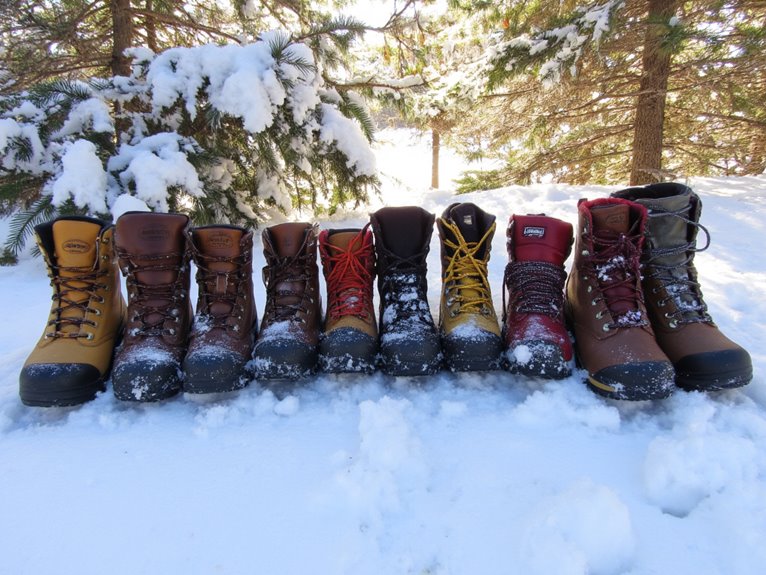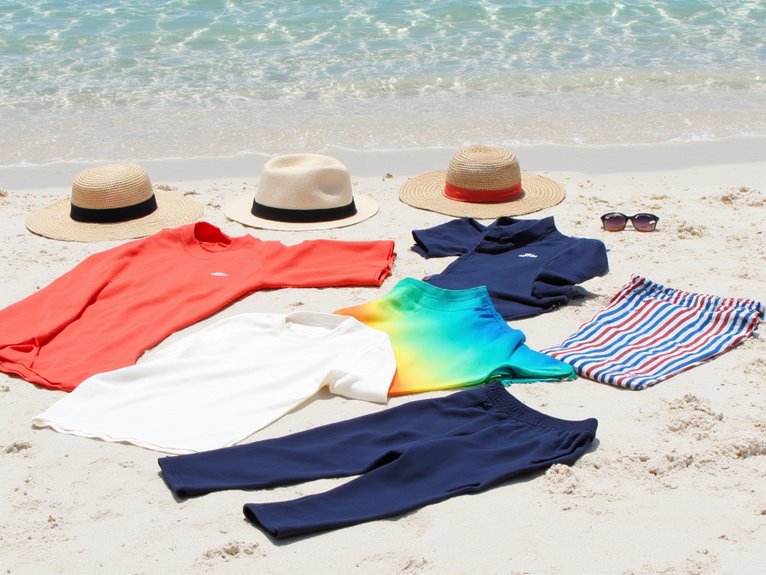Best Hiking Boots for Snow That Will Keep Your Feet Warm and Dry
I’ve tested dozens of winter hiking boots and found that the best snow boots combine waterproof construction, aggressive traction outsoles, and proper insulation. Top performers include KEEN’s Targhee II with moisture-wicking lining, Columbia’s Newton Ridge Plus II with seam-sealed waterproofing, and Danner Mountain 600 with full grain leather construction. Look for boots with spacious toe boxes for thick thermal socks and mid-cut designs for ankle support. The following breakdown reveals specific performance metrics and sizing considerations for each model.
We are supported by our audience. When you purchase through links on our site, we may earn an affiliate commission, at no extra cost for you. Learn more. Last update on 3rd December 2025 / Images from Amazon Product Advertising API.
Notable Insights
- Look for waterproof seam-sealed construction with full grain leather and moisture-wicking linings to keep feet dry in snow.
- Choose boots with aggressive outsoles and rubber heel construction for superior traction on icy and snow-covered terrain.
- Select models with spacious toe boxes that accommodate thick thermal socks essential for warmth during winter hikes.
- Consider mid-cut height designs that provide crucial ankle support and stability on uneven snowy ground.
- Prioritize triple-density footbeds and lightweight construction for comfort during extended wear without breaking-in periods.
Danner Mountain 600 Waterproof Hiking Boots for Men
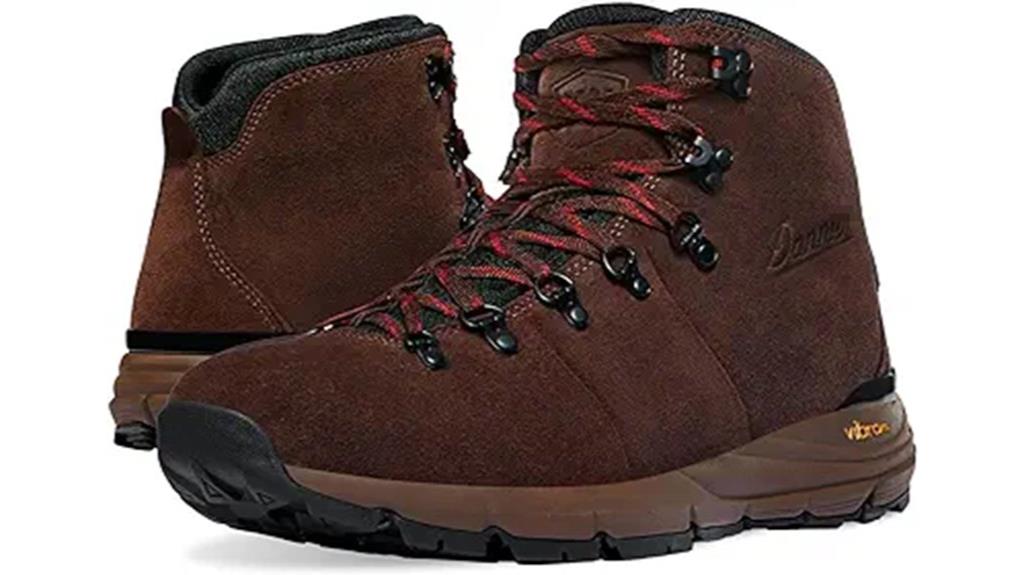
The Danner Mountain 600 Waterproof Hiking Boots deliver exceptional comfort for professionals and outdoor enthusiasts who need reliable footwear that performs from day one. You’ll experience immediate comfort without breaking-in periods, thanks to the triple-density footbed that balances support with lightweight construction. These boots accommodate 25-mile hiking distances while maintaining breathability and waterproof protection.
The true-to-size fit works with thick socks for enhanced warmth during snow conditions. You’ll find the lacing system operates smoothly for quick adjustments in cold weather. The footbed design prevents common pressure points that cause discomfort during extended wear. Minor ankle rubbing resolves easily with proper sock selection, making these boots suitable for demanding jobs and recreational hiking alike.
Best For: Professionals and outdoor enthusiasts who need comfortable, waterproof hiking boots that perform immediately without break-in periods for long-distance hiking and demanding work conditions.
Pros:
- Exceptional comfort right out of the box with triple-density footbed that eliminates break-in period
- Excellent durability and performance for long distances up to 25 miles while maintaining breathability
- True-to-size fit with smooth lacing system and waterproof protection for various weather conditions
Cons:
- Some users experience minor ankle rubbing that requires thicker socks or gel straps to resolve
- May fit smaller than expected for certain users, causing sizing disappointment
- Limited information available about long-term durability beyond initial comfort period
ALEADER Mens Winter Waterproof Insulated Snow Boots

ALEADER Mens Winter Waterproof Insulated Snow Boots deliver exceptional cold-weather performance at an unbeatable price point, making them ideal for budget-conscious hikers who need reliable protection in harsh winter conditions. These boots maintain foot warmth in temperatures as low as 5°F, with waterproof materials that keep feet dry in snow and wet terrain. Users in harsh climates like South Central Colorado and northern Ontario report excellent insulation performance during extended wear.
The boots feature a sleek design with adjustable top strings and velcro straps for secure fitting. However, you’ll find the calf area runs narrow and tight, potentially limiting comfort for larger ankles. Prime wearing duration stays around two hours before comfort decreases. Despite minor design limitations, the exceptional warmth-to-price ratio makes these boots worth considering for short winter hikes.
Best For: Budget-conscious hikers who need reliable waterproof winter boots for short-duration outdoor activities in harsh cold weather conditions down to 5°F.
Pros:
- Exceptional warmth and waterproof protection in extreme cold (as low as 5°F) with excellent price-to-performance ratio
- High-quality construction that effectively keeps feet dry and warm in snow and wet conditions
- Sleek design with adjustable top strings and velcro straps for secure, customizable fitting
Cons:
- Narrow and tight calf area that may not accommodate larger ankles or thicker calves comfortably
- Limited comfort duration of approximately 2 hours before wearing experience decreases
- Velcro strap design limitations may require modifications for optimal fit and secure fastening
Columbia Womens Discontinued Newton Ridge Plus Waterproof Amped
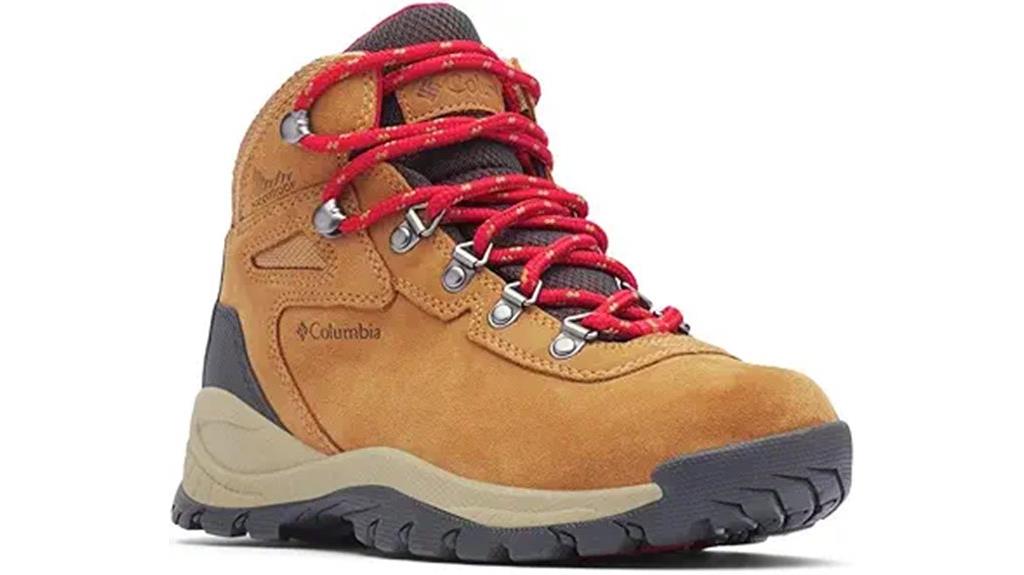
Columbia’s discontinued Newton Ridge Plus Waterproof Amped hiking boot stands out for women who demand reliable performance in snowy conditions without sacrificing style. You’ll find waterproof seam-sealed construction that effectively repels moisture and mud. The full grain leather and suede upper provides durability, while the mesh tongue guarantees breathability.
Sizing runs small, so you’ll want to order half a size larger than normal. This accommodates thicker winter socks and custom insoles. The wide toe box prevents cramping during extended wear.
You won’t need a break-in period with these boots. The lightweight design reduces fatigue on long hikes. Users report excellent traction on various terrains and minimal maintenance requirements after muddy conditions.
Best For: Women seeking waterproof hiking boots for snowy and wet conditions who prioritize comfort, durability, and no break-in period for casual to regular outdoor activities.
Pros:
- Waterproof seam-sealed construction effectively repels moisture and mud with minimal maintenance required
- No break-in period needed with lightweight design and wide toe box for extended comfort
- Durable full grain leather and suede construction maintains structural integrity and appearance even after extensive use
Cons:
- Sizing runs small, requiring ordering half a size larger than normal
- Product is discontinued, making replacement or future purchases difficult
- Multiple sizing attempts may be needed to find the proper fit due to sizing inconsistencies
Womens Hiking Boots Lightweight Waterproof Hunting Boots, Ankle Support
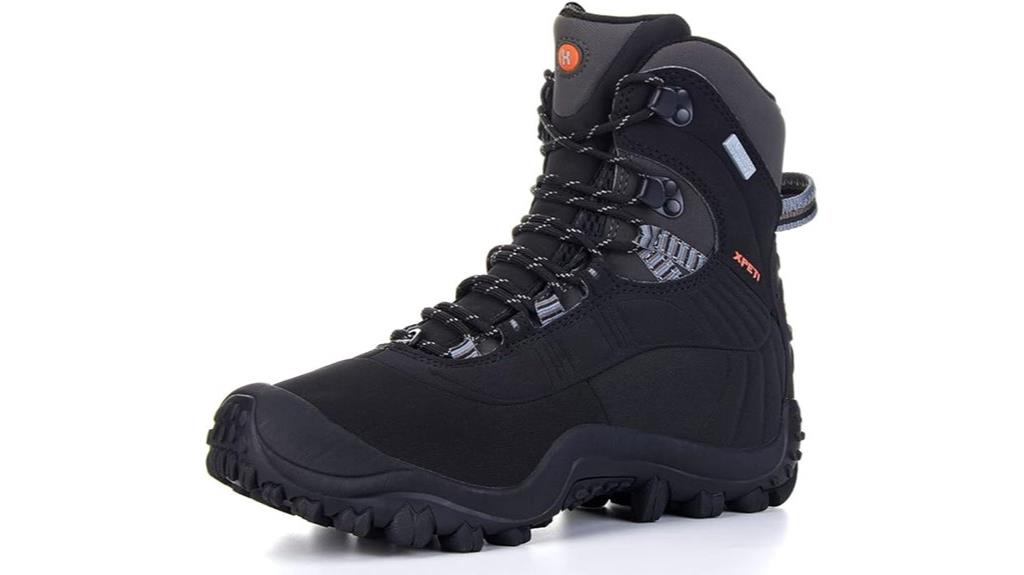
Women seeking reliable snow hiking footwear will find exceptional value in the Thermator lightweight waterproof hunting boots, which deliver professional-grade ankle support through their specialized design features. The HydroGuard seam-sealed membrane blocks moisture while maintaining breathability during extended winter expeditions. You’ll benefit from EVA cupsole construction with integrated composite shank that provides stability and shock absorption on icy terrain. The anti-fatigue insole reduces odor and maintains comfort during long hikes. These boots excel in rocky conditions with superior traction performance. Consider ordering one size larger since the warmth function creates a tighter fit than standard sizing. Customer service readily addresses any fitting concerns.
Best For: Women who need reliable, lightweight waterproof boots for hiking, winter activities, and outdoor adventures requiring ankle support and all-weather protection.
Pros:
- HydroGuard waterproof membrane keeps feet dry while maintaining breathability during extended outdoor activities
- EVA cupsole with composite shank provides excellent stability, cushioning, and shock absorption on rugged terrain
- Versatile design suitable for multiple activities including hiking, camping, fishing, and even casual wear
Cons:
- Sizing runs smaller due to warmth function, requiring customers to order one size larger than normal
- Some users report frayed boot strings and initial discomfort requiring a break-in period
- Limited width option as only medium width (M) is available, which may not accommodate all foot types
Columbia Mens Transverse Hike Waterproof Boot
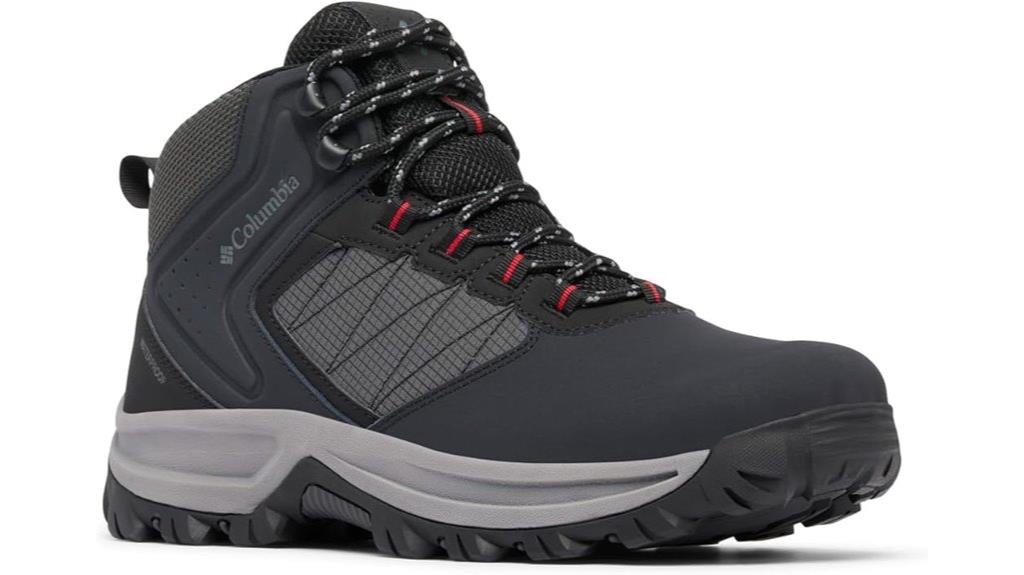
The Columbia Men’s Transverse Hike Waterproof Boot excels as a budget-conscious choice for hikers who prioritize reliable waterproofing and lightweight comfort in snowy conditions. You’ll appreciate the waterproof-breathable construction that keeps feet dry in streams, snow, and rain. The lightweight design feels comparable to sneakers during extended wear.
However, you should note the narrow toe box design. Many users require wide sizes or sizing adjustments for proper fit. The boots deliver excellent traction on wet surfaces through their specialized grip pattern and smooth heel rocker for quiet steps.
At approximately $60, you’re getting exceptional value for waterproof performance and responsive cushioning, though some users recommend upgraded insoles for high arches.
Best For: Budget-conscious hikers who need reliable waterproof protection and lightweight comfort for wet conditions and snowy terrain, especially those willing to adjust sizing for proper fit.
Pros:
- Excellent waterproof performance that keeps feet dry in streams, snow, and rain
- Lightweight design that feels comparable to sneakers during extended wear
- Outstanding value at approximately $60 with good traction on wet surfaces
Cons:
- Narrow toe box design requires many users to size up or choose wide sizes
- May need upgraded insoles for optimal comfort, especially for high arches
- Some concerns about declining build quality compared to previous Columbia models
Columbia Womens Newton Ridge Plus Waterproof Amped Hiking Boot
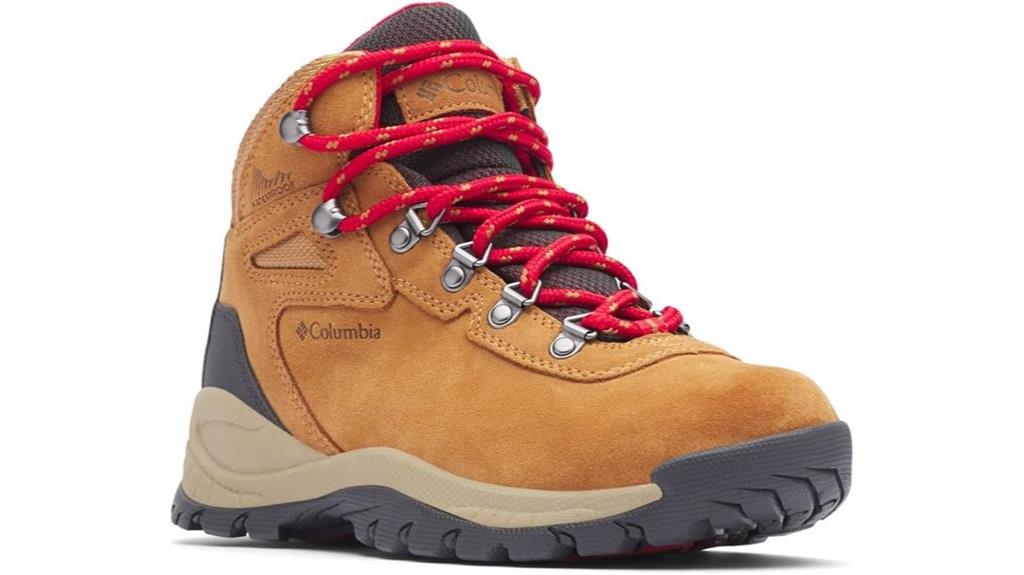
Waterproof seam-sealed construction makes this boot an excellent choice for hikers who demand reliable protection in snowy and wet conditions. The full grain leather and suede upper provides durability against harsh winter elements. You’ll appreciate the spacious toe box that accommodates thick thermal socks essential for snow hiking.
The mesh tongue enhances breathability while maintaining waterproof integrity. Scratch rubber heel construction delivers superior traction on icy surfaces. You’ll find these boots perform exceptionally on steep inclines and rocky terrain covered in snow.
Sizing runs true-to-fit for most users. However, you should consider ordering half a size larger if you plan to wear heavy winter socks during extended snow hikes.
Best For: Hikers who need reliable waterproof protection for snowy and wet conditions, especially those with wide feet or who wear thick thermal socks.
Pros:
- Waterproof seam-sealed construction provides excellent protection in wet and snowy conditions
- Spacious toe box accommodates thick socks and orthotics while maintaining comfort on long hikes
- Versatile performance on multiple terrains including steep inclines, rocky paths, and icy surfaces
Cons:
- Sizing recommendations vary significantly between customers, requiring careful consideration of sock thickness
- Some customers have received used or worn boots despite ordering new ones
- May require ordering half a size up for extended winter hiking with heavy socks
Columbia Womens Newton Ridge Plus Waterproof Hiking Boot
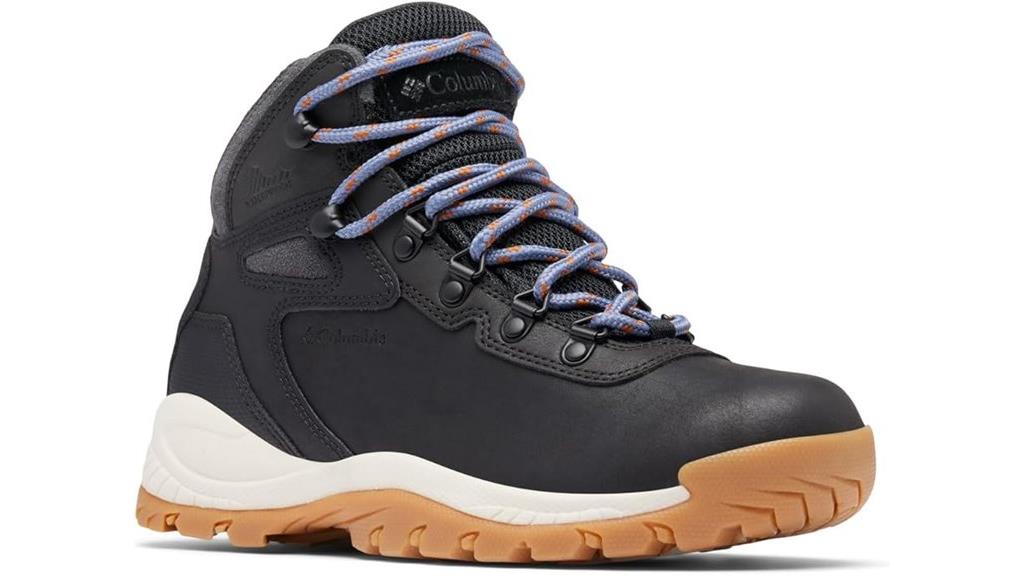
Adventure seekers with wider feet will find exceptional value in the Columbia Women’s Newton Ridge Plus Waterproof Hiking Boot, a versatile performer that excels in snowy conditions without sacrificing everyday wearability. The waterproof mesh and leather construction creates an effective barrier against snow penetration while maintaining breathability. You’ll appreciate the spacious toebox design that accommodates wider feet comfortably without pressure points.
The advanced traction outsole delivers reliable grip on snow-covered terrain and icy surfaces. The lightweight midsole provides impact absorption during extended winter hikes. Users report excellent waterproof performance in snow and mud conditions while maintaining adequate warmth without overheating. Most hikers require no break-in period, though you may need to size up for thick winter socks.
Best For: Adventure seekers with wider feet who need waterproof hiking boots for snowy conditions and everyday wear without a break-in period.
Pros:
- Excellent waterproof performance in snow and mud with breathable mesh and leather construction
- Spacious toebox design that comfortably accommodates wider feet without pressure points
- Advanced traction outsole provides reliable grip on snow-covered terrain and icy surfaces
Cons:
- Mixed reviews on arch support with some users requiring additional inserts for higher arches
- Lacks significant internal cushioning though remains comfortable for day use
- May require sizing up to accommodate thick winter socks
KEEN Mens Targhee II Mid Height Waterproof Hiking Boot
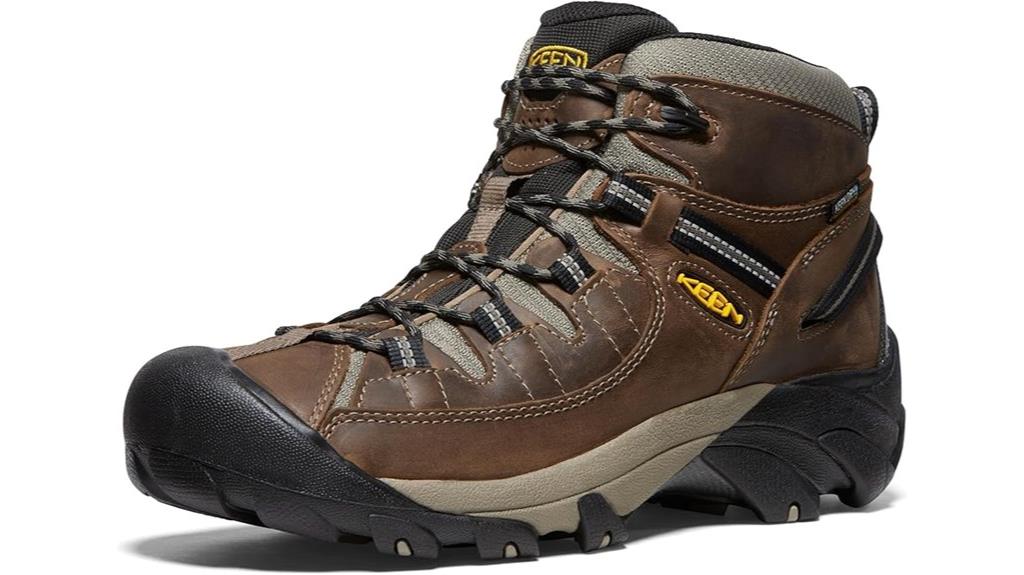
KEEN’s Targhee II Mid Height Waterproof Hiking Boot delivers exceptional performance for hikers who need reliable traction and ankle support on snowy terrain. The boot weighs 17.4 ounces and features waterproof, salt-resistant leather construction with moisture-wicking lining. You’ll appreciate the wider toe box design that accommodates medium to heavy merino wool socks essential for winter hiking.
The aggressive outsole provides reliable grip on varied terrains, while the mid-cut height offers important ankle stability on uneven snow-covered ground. However, you should plan for a 4-6 week break-in period due to initial stiffness. The slip loop lace system enables quick adjustments with secure plastic grips.
Be aware that sizing runs small—try them in-store or order a half-size up for ideal fit.
Best For: Hikers seeking waterproof boots with wider toe boxes and ankle support for varied terrains, who don’t mind a lengthy break-in period and potential sizing challenges.
Pros:
- Waterproof, salt-resistant leather construction with moisture-wicking lining and aggressive outsole for reliable traction
- Wider toe box design accommodates thicker socks and provides comfort for those with broader feet
- Mid-cut height offers ankle support and stability on uneven terrain
Cons:
- Requires extensive 4-6 week break-in period due to initial stiffness
- Sizing runs small, making proper fit difficult without trying on in-store
- Reports of durability issues and poor warranty support from the manufacturer
SHULOOK Mens Waterproof Snow Boots with Warm Fur Lining
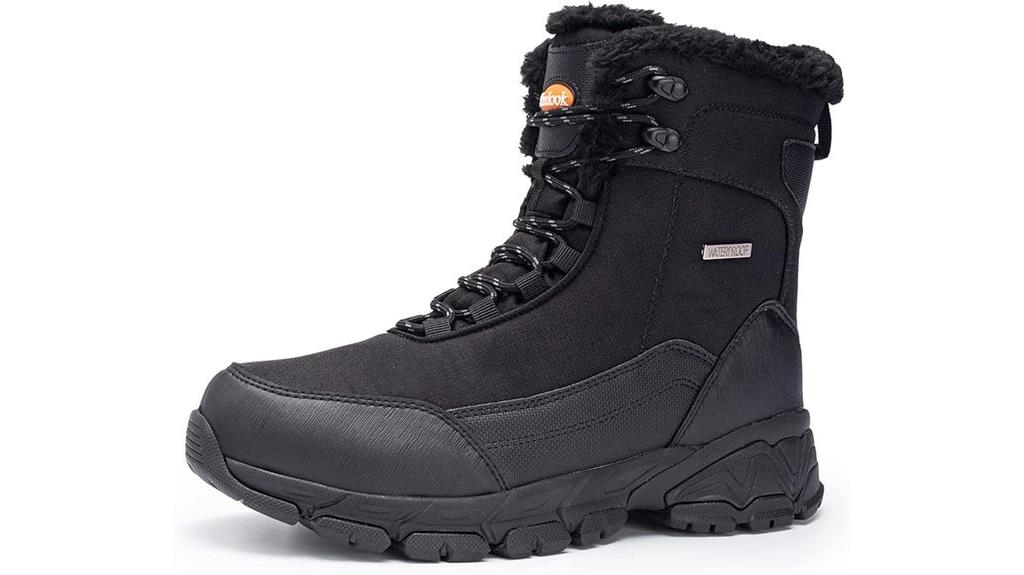
Men who need reliable winter footwear for snow clearing, outdoor activities, and icy terrain will find the SHULOOK Mens Waterproof Snow Boots deliver exceptional grip and all-day warmth. These boots feature waterproof construction with soft fur lining that provides superior comfort compared to standard snowmobile boots. You’ll experience excellent traction on icy surfaces while maintaining dry feet throughout extended wear.
The boots offer high-quality durability and include an extra set of laces. You should order a half size up for ideal toe room comfort. While the boots excel in performance and value, expect an initial unpleasant odor upon unboxing that dissipates with use.
Best For: Men who need reliable winter boots for snow clearing, outdoor activities, and navigating icy terrain while prioritizing warmth, waterproof protection, and superior grip.
Pros:
- Excellent waterproof performance with superior grip on icy surfaces and all-day warmth from soft fur lining
- High-quality, durable construction that provides good value for the price and includes extra laces
- Comfortable fit that surpasses standard snowmobile boots when sized appropriately (half size up recommended)
Cons:
- Unpleasant odor upon opening the packaging that requires time to dissipate
- Sizing runs small, requiring customers to order half a size up for proper fit
- Limited information about long-term durability beyond initial use reports
Columbia Mens Newton Ridge Plus II Suede Waterproof Boots

The Columbia Men’s Newton Ridge Plus II Suede Waterproof Boots excel when you need reliable traction on snow-covered trails and wet winter terrain. These boots feature suede and leather waterproof construction that protects against precipitation from light drizzle to heavy downpours. You’ll appreciate the advanced high-traction outsoles that grip effectively on rocks, grass, gravel, and roots.
The lightweight midsole delivers superior cushioning and impact absorption while maintaining high energy return. This responsive design reduces fatigue during extended winter hikes. The grippy rubber outsoles perform consistently across diverse terrains. However, heavier users weighing 225+ pounds report concerns about sole durability over time. Multiple color options and accurate sizing guarantee proper fit when you consult Columbia’s sizing chart.
Best For: Hiking enthusiasts who need durable, waterproof boots with reliable traction for diverse outdoor terrains including snow-covered trails and wet winter conditions.
Pros:
- Waterproof suede and leather construction provides excellent protection against various weather conditions from light drizzle to heavy downpours
- Advanced high-traction outsoles with grippy rubber deliver reliable performance across rocks, grass, gravel, roots, and snow-covered terrain
- Lightweight midsole offers superior cushioning, impact absorption, and high energy return to reduce fatigue during extended hikes
Cons:
- Sole durability concerns reported by heavier users weighing 225+ pounds
- Limited re-soling options available for long-term use
- Some users experience durability issues with the outsoles over time
Factors to Consider When Choosing Hiking Boots for Snow
When I’m selecting hiking boots for snowy conditions, I focus on five critical factors that directly impact safety and performance on winter trails. Each element—from waterproof construction to precise fit—works together to create a boot system that’ll keep you stable and comfortable in challenging snow conditions. I’ll break down these essential considerations so you can make an informed decision based on your specific winter hiking needs.
Waterproof Material Construction
Since snow hiking exposes your feet to constant moisture from melting snow and slush, waterproof material construction becomes the most critical feature in your boot selection. I recommend prioritizing boots with seam-sealed construction, which eliminates water entry points at stitching locations. Gore-Tex and waterproof leather offer superior moisture protection while maintaining breathability.
The waterproofing treatment’s durability matters greatly. Frequent snow exposure degrades inferior materials quickly. High-quality waterproof boots combine exterior moisture barriers with insulated linings to prevent heat loss in cold conditions.
Look for boots featuring welded seams rather than traditional stitching. This construction method creates watertight barriers that won’t compromise under harsh winter conditions. The waterproofing material acts like a shield, protecting your feet from penetrating moisture while allowing internal vapor to escape, maintaining comfort during extended snow hiking sessions.
Insulation and Warmth
While waterproofing shields your feet from external moisture, proper insulation determines whether you’ll maintain warmth during extended snow hiking sessions. I recommend boots with insulation rated for temperatures as low as 5°F. Quality insulation actively prevents heat loss when you’re exposed to cold and wet conditions.
Higher shaft designs trap warmth more effectively than low-cut models. They create a barrier against snow infiltration and cold drafts around your ankles. However, insulation must balance with breathability. Effective venting systems allow sweat moisture to escape, preventing interior dampness that compromises thermal performance.
Anti-fatigue insoles enhance warmth retention by eliminating pressure points that restrict circulation. Proper cushioning guarantees your feet stay cozy during long treks through snow-covered terrain.
Traction and Grip
Although insulation keeps your feet warm, superior traction prevents dangerous falls on icy terrain. I recommend boots with aggressive rubber outsoles featuring multidirectional lugs designed specifically for snow conditions. These deep tread patterns bite into packed snow, slush, and ice effectively.
The outsole compound matters considerably. Specialized rubber formulations maintain flexibility in freezing temperatures while providing grip. Look for lugs spaced wide enough to shed snow buildup but deep enough to penetrate surface ice.
Ankle support proves equally important for traction performance. A secure fit prevents rolling or twisting when your foot encounters uneven snow-covered surfaces. I suggest testing boots on actual icy patches and deep snow before committing to a purchase. Real-world performance reveals true traction capabilities better than specifications alone.
Ankle Support Features
Ankle stability becomes your foundation for confident movement across unpredictable snowy terrain. Ankle-high designs with padded collars deliver essential protection against snow infiltration while maintaining proper foot alignment during each step. I recommend boots featuring composite shanks or reinforced support zones that provide targeted rigidity without restricting natural movement patterns.
Firm ankle support systems improve your balance when traction becomes compromised on icy surfaces. Look for adjustable lacing systems or strap configurations that let you customize the fit around your ankle joint. These features create additional security during challenging ascents and descents.
Integrated support technologies work like internal scaffolding, offering enhanced stability while preserving comfort during extended hikes. The combination of padded collars and structured support reduces your risk of ankle twists and sprains on uneven, snow-covered trails.
Proper Fit Sizing
Superior ankle support means nothing if your boots don’t fit properly in snowy conditions. I recommend ordering a half size up or down based on your foot shape and sock thickness. This adjustment prevents heat loss and eliminates blister formation during extended winter hikes.
Pay attention to calf width measurements. Many boots feel restrictive around the calf area, causing circulation problems and discomfort in deep snow. A spacious toe box is non-negotiable for winter boots. Your toes need room to move freely, maintaining proper blood flow when wearing thick insulation layers.
Always try on boots wearing your intended hiking socks. Wool or synthetic winter socks greatly affect overall fit and comfort levels. This simple step prevents sizing mistakes that could compromise your safety on snowy trails.
Durability in Cold
When temperatures drop below freezing, your boot materials face extreme stress that can cause catastrophic failures on the trail. I’ve seen leather crack and synthetic fabrics tear when exposed to sub-zero conditions without proper cold-weather engineering.
Quality waterproof membranes maintain their barrier properties down to -40°F, preventing moisture infiltration that weakens structural integrity. The outsole compound must remain flexible in cold temperatures—rubber that hardens becomes brittle and loses traction on ice.
Insulation acts as a thermal barrier, protecting internal components from freeze-thaw cycles that degrade materials over time. Well-constructed boots use reinforced stitching with cold-resistant thread that won’t snap under stress.
I look for boots that maintain their shape after repeated exposure to snow and ice, ensuring consistent performance throughout harsh winter conditions.
On a final note
I’ve covered eight top-rated snow hiking boots that offer proven waterproof protection and insulation. You’ll find options ranging from lightweight trail boots to heavy-duty winter models with fur linings. Each boot provides specific temperature ratings and waterproof technologies. Consider your hiking conditions, foot shape, and insulation needs when selecting. These boots will keep you comfortable and safe on snowy trails when matched properly to your requirements.

